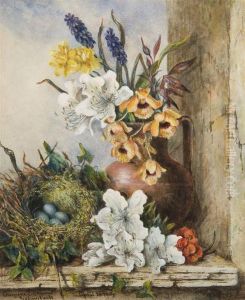Georgiana E. Ormrod Paintings
Georgiana E. Ormrod was an English artist born in 1864, known for her contributions to the art world primarily as a watercolour painter. Her life and work were profoundly influenced by the cultural and artistic movements of her time, reflecting the Victorian and Edwardian eras' sensibilities and the transition towards modernism. Despite the challenges faced by women in the arts during this period, Ormrod managed to carve out a space for herself within the artistic community, contributing to the rich tapestry of British art history.
Ormrod's artistic journey began at a young age, influenced by the burgeoning arts scene in Britain and the increasing opportunities for women to receive formal art education. She was part of a generation of women artists who began to gain recognition and opportunities, albeit slowly, in a field that was predominantly male-dominated. Ormrod's work often focused on landscapes and nature, capturing the essence of the English countryside with a delicate touch and a keen eye for detail. Her watercolours are noted for their vivid colours, light, and atmospheric qualities, showcasing her skill in manipulating the medium to create depth and texture.
Throughout her career, Georgiana E. Ormrod exhibited her work at various prestigious venues, including the Royal Academy of Arts, though the extent of her exhibitions and her involvement in the art community remains a subject of research. Her contributions, like those of many women artists of her era, were somewhat overshadowed by her male contemporaries, and as a result, her work is not as widely recognized today as it deserves to be.
Georgiana E. Ormrod's legacy is that of a talented artist who navigated the challenges of her time to pursue her passion for painting. Her work serves as a testament to the enduring quality of watercolour as a medium and provides insight into the artistic explorations of women in the late 19th and early 20th centuries. Ormrod passed away in 1934, leaving behind a body of work that continues to be appreciated by those who discover it, offering a glimpse into the landscape and ethos of her time.
